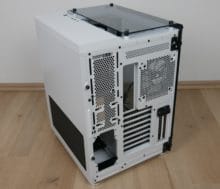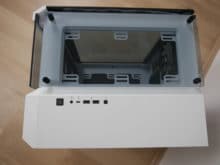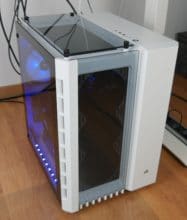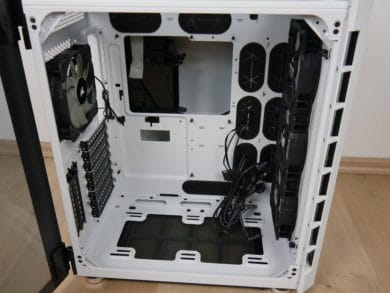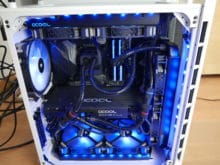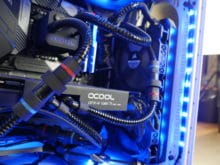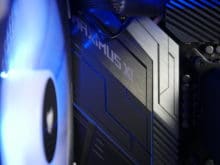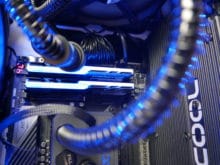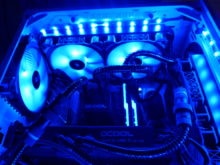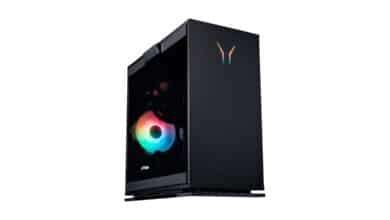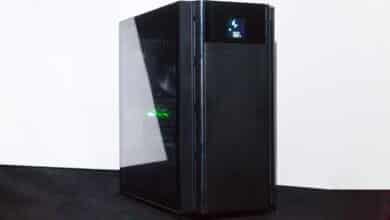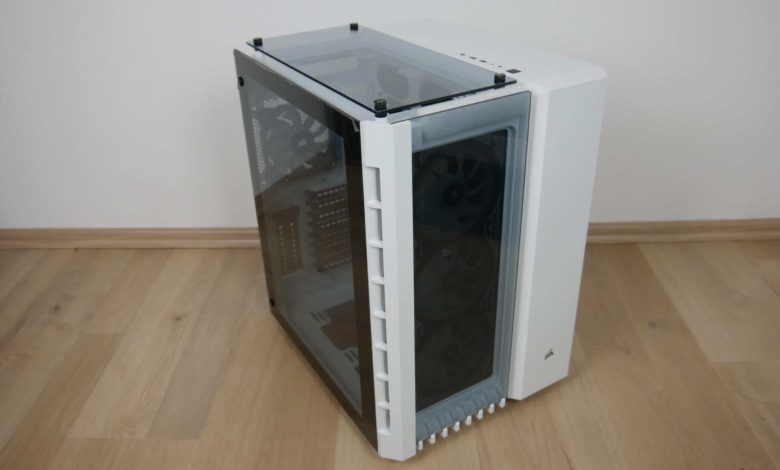
Anyone interested in larger cases will sooner or later miss the Corsair Crystal Series 680X RGB. It offers a lot of storage space for the components and various cooling elements. However, we asked ourselves what really fits into the case. We equipped ourselves with three 280 radiators and tried to set up a high-end system that would still be quiet. But before we go into the details of the system, let’s take a closer look at the case.

Technical Details
| Model | Corsair Crystal Series 680X RGB white |
| Housing type | Midi Tower |
| Dimensions | 344 mm (W) x 505 mm (H) x 423 mm (D) |
| Weight | approx. 11.58 kg |
| Material | Steel, Tempered Glass, Plastic |
| Color | white (also available in black) |
| Front connections | 2x USB 3.0, 1x USB 3.0 Type C, 1x microphone / headphones combined |
| Drive bays | 3x 3.5″ (internal) 4x 2.5″ (internal) |
| Extension slots | 8 (horizontal), 2 (vertical) |
| Form factors | E-ATX, ATX, mATX, ITX |
| Ventilation | Front: 3x 120 mm (standard RGB ) / 2x 140 mm Lid: 2x 140 mm / 2x 120 mm Rear: 1x 120 mm (standard) / 1x 140 mm bottom: 2x 120 mm / 2 x 140 mm |
| Radiators | Front: 280 mm / 360 mm Lid: 240 mm / 280 mm Back side: 120 mm bottom: 240 mm / 280 mm |
| Max. CPU cooler height | 180 mm |
| Max. Graphics card length | 505 mm |
| Power supply unit | ATX |
| mains part length | 225 mm |
| Price | € 343.00 * |
| Special features | addressable RGB fans, Tempered Glass, dual chamber layout |

Packaging and Scope of Delivery
The Crystal 680X is delivered in a giant cardboard box. Everything is, as you are used to it, well packed in polystyrene and thus protected against shocks. In order to better protect the glass, the glasses are covered with a protective film and the entire case is once again wrapped in a fabric.
All necessary screws, spacers and much more are included in the scope of delivery. Also a few cable ties for the appropriate cable management are included.
Exterior
From the outside, the Corsair Crystal 680X RGB already makes a great impression. The three sides, which are provided with tempered glass, give a really good view of everything inside the case. In combination with RGB fans, you can really make something chic out of it. For our test, however, the LL120 fans are replaced. Even though the white case requires a bit more care, we think it’s very stylish and adapts very well to the rest of the design.
No matter what you look at from the outside, you simply won’t find anything to criticize.
The glass pane at the top can be easily removed using the four knurled screws and the side window is no problem either. It is magnetically held in place. The door can be opened via the rear hinge. Only one screw must be loosened, if the disk is to be completely removed. However, the windscreen cannot be removed.
What is noticeable is that the front panel, which is located on the upper side, offers some connections, but does not provide an HDD LED. There are two USB 3.0 ports and a combined 3.5mm jack connector and that should be enough for most. Separate inputs and outputs would have been good for the jack connector, but many headsets also have a combined plug in conjunction with a Y-cable. As a useful addition, the front panel also includes a USB 3.1 type C connector.
Inside Impression
Inside, the Corsair case offers plenty of space. All components also find their place with a suitable water cooling system and the two-chamber layout allows everything to be wired beautifully.
What’s striking inside, though, are the grids. Instead of using real dust filters, only coarse metal grids are used here. These look chic, but don’t keep the dust out. Here we would have wished for something different with the price.
Let’s go into a little detail. The interior for the components offers a lot of space and four pre-assembled fans, in the front there are three LL120 RGB fans and a SP120 fan at the back to provide a good airflow ex factory.
In the front there’s a removable bracket, so you can easily mount the fans and/or radiators outside the case and then just put the bracket back in again. The same procedure is also used for the lid. Here, however, the space at the bottom becomes a bit narrow if you install a radiator. All cables that are to be plugged into the mainboard from above should be pulled through the openings before inserting the bracket.
The openings that lead into the second chamber are covered with rubber, which also gives a high-quality impression.
Both the horizontal and the two vertical slot bezels are screwed together and can therefore be used again and again.
An RGB controller is already installed ex works, which can control the RGB LEDs of the fans and additionally LED strips. This is a plus point, especially in combination with the cable routing ex works. But what some users of the case will certainly add is a fan controller, which is not included.

Let’s have a look into the quite big second chamber. The cover is fixed at the back with two screws and can easily be pulled out after loosening.
The power supply unit is installed vertically in the chamber, so the possibly integrated power supply fan is not located as usual, but stands. The hard disk cages are then fixed above the power supply unit. Dismantling is a bit cumbersome, but possible.
A total of up to three 2.5/3.5 inch data carriers fit into the lower cage and up to four 2.5 inch data carriers fit into the upper cage. More than enough space for data storage.
The remaining part of the second chamber can be used to design the cable management according to your wishes. There is also space for an additional fan controller.
If you want to try a custom water cooling system, take a look at the Crystal 680X from Corsair. With a little help, such as a drain port, a cool and functional solution can also be found here.
The workmanship and the construction of the case are top!
System Contruction in the Corsair Crystal Series 680X RGB
First of all, we would like to emphasize once again that we are not primarily concerned with the appearance here, but mainly with the cooling performance of the system with inaudible fans. Therefore we use three 280 mm radiators (3x Alphacool NexXxoS ST30 Eiswolf *). All three radiators are installed in a circuit with GPU and CPU. The GPU is a Nvidia GeForce GTX 1080 Ti from MSI in the Duke OC version, on which the Alphacool Eiswolf GPX Pro M16 cooling block and a backplate were installed. The CPU is a Intel-Core i9-9900k with the Polar 280* cooling block from Alphacool.
The whole thing is mounted on the Asus ROG Maximus XI Hero*. To provide the system with suitable memory, 32GB G.Skill Trident Z RGB* RAM was installed. Altogether seven Corsair ML140* fans were installed in the system, which are controlled by the Corsair Commander Pro* and the Lightning Node Pro*. There are also three RGB strips to add more color to the system.
As you can see, there are quite a few components in the system, but we also expect corresponding performance.
Now we come to the installation of the components. According to Corsair, there is room for three 280 radiators in the case, so we’re very excited to see how the whole thing fits together. The construction is very simple due to the removable elements and doesn’t present any major difficulties. Only the already mentioned space in the upper area is a problem.
The two-chamber layout leads to very simple cable management. But when we then take care of the water cooling, it quickly becomes clear that it will be really tight. After four unsuccessful attempts to fit everything into the case, the fifth is probably the best variant. As you can see in the pictures, there is simply no more room between the radiators and the fans. Unfortunately, this also means that some savings have to be made on the screw connection. Not all screws fit into the slots provided, but the result shows: It fits! Now the only question is: does it work?
Lighting, Cooling Power and Noise Level
There is more than enough pure cooling power available due to the built-in radiators and the fans should also be more than suitable for this. Even if the components generate a lot of waste heat, we should get this under control with this and with almost inaudible fans.
So let’s let the components work with Prime95 and FurMark for 15 minutes:
| Outdoor temperature | 19° |
| Graphics card | 40° |
| CPU | 45° |
Relatively speaking, the outside temperature is somewhat low, but the outstanding cooling performance of the system is still evident. The graphics card doesn’t get warmer than 40 degrees and also the CPU is far below a questionable limit of only 45 degrees. If the performance isn’t enough, there’s still a lot of potential for overclocking. The way the system runs now, it is audible with a maximum of 36 dB, but definitely not disturbing. The fans rotate at a maximum of 1200 revolutions per minute. A real top result, which results in the performance in interaction with the temperature.
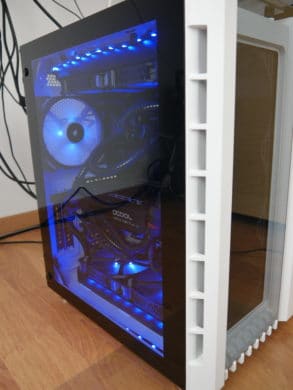
Conclusion of the Corsair Crystal 680X RGB Review
Let’s summarize what we found during the tests:
The system design in general is well thought out and really simple due to the two-chamber layout. Cable management is also very simple. If, like us, you don’t want to pay too much attention to the exterior look, but rather to the cooling performance, you can even install three 280 mm radiators, but the space is very limited. Alternatively, the sizes can of course be adjusted so that 360- or 240-mm radiators could be installed if the somewhat louder 120-mm fans didn’t bother you.
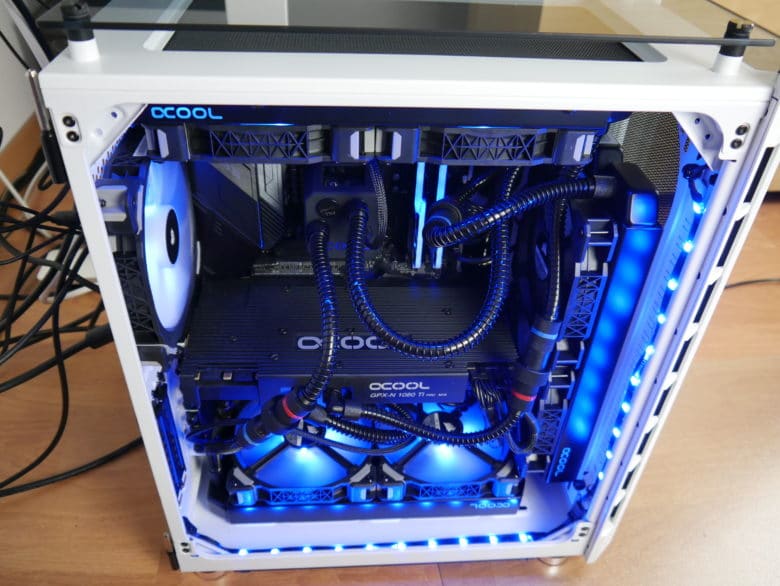
Included are grids that can be used as dust filter replacements. However, these are so coarse that they cannot stop the dust and the system can never be dust-free.
In addition, it would have been nice if the hard disks could be mounted decoupled. If you still use an HDD, the whole case can vibrate and become a noise source.
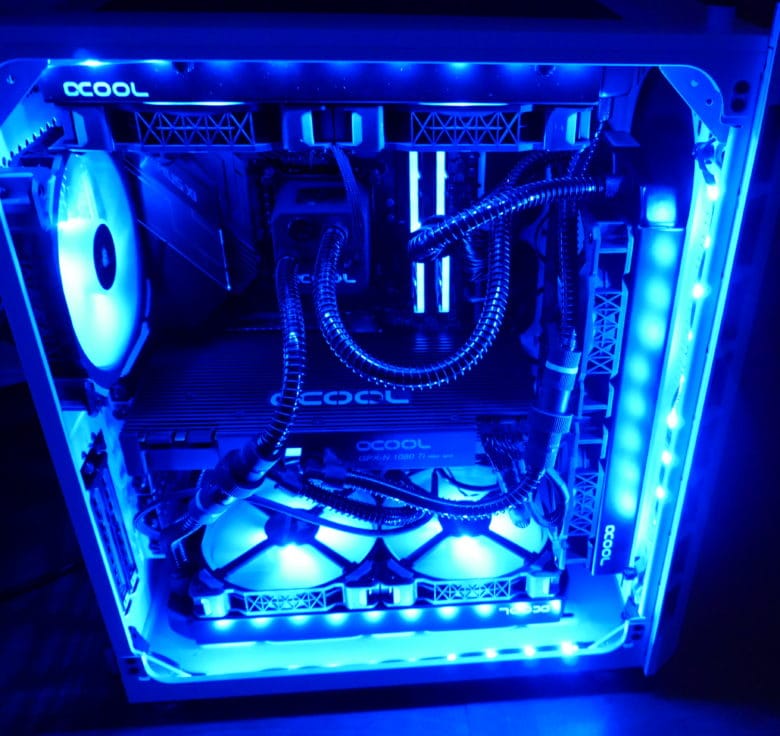
Otherwise we are completely convinced of the Corsair Crystal Series 680X RGB. You have plenty of room to really build a powerful and quiet system, but you also have to dig a little deeper into your pocket.
Corsair Crystal 680X RGB
Workmanship
Features
Structure
Cooling
Value for Money
Pretty good case, with little room for improvement.



